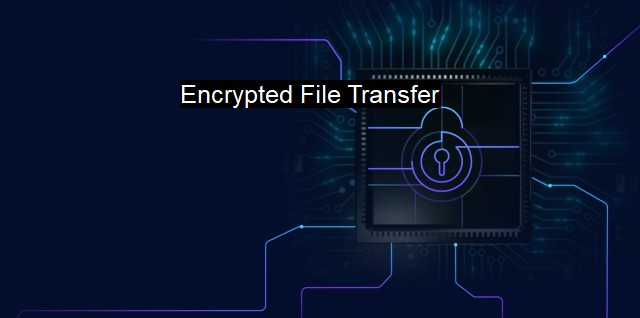What is Encrypted File Transfer?
The Importance of Encrypted File Transfer in Modern Cybersecurity: Safeguarding Data and Protecting Business Reputation
Encrypted File Transfer is a critical concept and method in cybersecurity used for the secure transmission of digital data over different forms of networks, which can include Local Area Networks (LANs), Wide Area Networks (WANs), and over the Internet. Encryption is a process that employs mathematical computations, performed by an algorithm or a cipher, to covert normal data, referred to as plaintext or cleartext, into indecipherable gibberish called ciphertext.In Encrypted File Transfer, digital data, in the form of files, are encrypted before being transmitted across a network to a recipient. Such a practice has proved pivotal in preventing unauthorized access, disclosure, and modification, alleviating the risk of data breaches.
As the unprecedented surge in cyber-attacks and related threats continue to threaten data privacy and security, organizations around the world, governmental, business, and even individual users have all looked to Encrypted File Transfer as a cybersecurity tool they can depend on. A noteworthy factor is that file encryption can be performed at different levels. Files can either be individually encrypted, encryption at directory level, or the whole hard disk can be encrypted such that all files that reside on the disk become encrypted.
This approach is essentially a requisite for safeguarding sensitive information in a hostile, digital, active, and global battlefield. Encrypted File Transfer preserves the confidentiality of information, ensuring that only the intended recipient can read the data. It can also ensure data integrity by providing mechanisms that prove that the data has not been tampered with during transmission.
Encrypted File Transfer forms an integral part of antivirus solutions as well. The incapability of most antiviruses of performing meaningful scans of encrypted data is a well-known fact in the cybersecurity realm. antiviruses assuring encrypted file transfer exceptionally adds to their service offering.
Resting on encryption algorithms, user or system-generated keys, and key length, data files can be encrypted and securely transmitted. Advanced Encryption Standard (AES), Data Encryption Standard (DES), Triple DES, and Rivest-Shamir-Adleman (RSA) are some of the commonly used encryption standards today.
To decrypt the received data, the recipient must employ the same encryption keys which were used for the encryption. In many cases, public-key encryption like the RSA is used, which makes use of two keys—one public key for encryption and a private key for decryption. This allows its public key to be widely distributed and used by multiple senders while still providing unique decryption only available to those possessing the matching private key.
By implementing an encrypted file transfer system into their networks, firms can accomplish satisfactory compliance with numerous privacy laws, regulations, and criteria that have arisen over the recent years, such as the General Data Protection Regulation (GDPR), the Payment Card Industry Data Security Standard (PCI DSS), and the California Consumer Privacy Act, among others.
The importance of Encrypted File Transfer in our computing environments is undeniable. We live in a time where digital security tools aren't luxury, but a necessity, for individuals and for organizations alike. Although encryption may not be normally seen as a preventive measure, data encryption, and indeed Encrypted File Transfer, truly sits at the essence of a complete cybersecurity strategy.
While no security measure is entirely foolproof, Encrypted File Transfer is more critical now than it has ever been. As our daily lives become more digital, and vast numbers of diverse information types are exchanged frequently, it will be imperative for individuals, corporations, governments, and other entities to prioritize stringent security standards like encrypted file transfers to keep their data effectively secured in this increasingly interconnected world.

Encrypted File Transfer FAQs
What is encrypted file transfer?
Encrypted file transfer is a cybersecurity measure that involves encoding information in transit from one device to another. This helps ensure that unauthorized users cannot access the data being transferred.Why is encrypted file transfer important?
Encrypted file transfer is important because it helps protect against cyber threats such as hackers intercepting sensitive information in transit. It also helps comply with data privacy regulations which mandate the use of encryption to protect sensitive data.What are some tools for encrypted file transfer?
There are several tools available for encrypted file transfer such as SSL/TLS protocols, SFTP, and PGP encryption. Anti-virus software can also be used to scan files for any malicious code before they are transferred.How do I know if my file transfer is encrypted?
You can check if your file transfer is encrypted by looking for the padlock symbol in your browser or file transfer client. You can also check if the transfer protocol being used is encrypted such as HTTPS or SFTP. Additionally, you can use anti-virus software to scan files before transferring them to ensure they are not infected with malware.| | A | | | B | | | C | | | D | | | E | | | F | | | G | | | H | | | I | | | J | | | K | | | L | | | M | |
| | N | | | O | | | P | | | Q | | | R | | | S | | | T | | | U | | | V | | | W | | | X | | | Y | | | Z | |
| | 1 | | | 2 | | | 3 | | | 4 | | | 7 | | | 8 | | |||||||